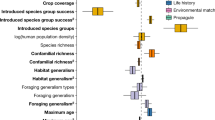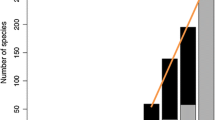Abstract
A central paradigm in invasion biology is that more releases of higher numbers of individuals increase the likelihood that an exotic population successfully establishes and persists. Recently, however, it has been suggested that, in cases where the data are sourced from historical records of purposefully released species, the direction of causality is reversed, and that initial success leads to higher numbers being released. Here, we explore the implications of this alternative hypothesis, and derive six a priori predictions from it. We test these predictions using data on Acclimatization Society introductions of passerine bird species to New Zealand, which have previously been used to support both hypotheses for the direction of causality. All our predictions are falsified. This study reaffirms that the conventional paradigm in invasion biology is indeed the correct one for New Zealand passerine bird introductions, for which numbers released determine establishment success. Our predictions are not restricted to this fauna, however, and we keenly anticipate their application to other suitable datasets.



Similar content being viewed by others
References
Beirne BP (1975) Biological control attempts by introduction against pest insects in the field in Canada. Can Entomol 107:225–236
Blackburn TM, Lockwood JL, Cassey P (2009) Avian invasions. The ecology and evolution of exotic birds. Oxford University Press, Oxford
Blackburn TM, Prowse TAA, Lockwood JL, Cassey P (2011) Passerine introductions to New Zealand support a positive effect of propagule pressure on establishment success. Biodiver Conserv 20:2189–2199
Cassey P (2001) Determining variation in the success of New Zealand land birds. Global Ecol Biogeogr 10:161–172
Caughley G, Gunn A (1996) Conservation biology in theory and practice. Blackwell Science, Oxford
Colautti RI, Grigorovich IA, MacIsaac HJ (2006) Propagule pressure: a null model for biological invasions. Biol Inv 8:1023–1037
Diamond J (1986) Overview: laboratory experiments, field experiments, and natural experiments. In: Diamond J, Case TJ (eds) Community ecology. Harper Row, New York, pp 3–22
Duncan RP (1997) The role of competition and introduction effort in the success of passeriform birds introduced to New Zealand. Am Nat 149:903–915
Duncan RP, Blackburn TM (2002) Morphological over-dispersion in game birds (Aves: Galliformes) successfully introduced to New Zealand was not caused by interspecific competition. Evol Ecol Res 4:551–561
Duncan RP, Forsyth DM (2006) Competition and the assembly of introduced bird communities. In: Cadotte MW, McMahon SM, Fukami T (eds) Conceptual ecology and invasions biology. Springer, UK, pp 415–431
Duncan RP, Blackburn TM, Sol D (2003) The ecology of bird introductions. Annu Rev Ecol Evol Syst 34:71–98
Duncan RP, Blackburn TM, Cassey P (2006) Factors affecting the release, establishment and spread of introduced birds in New Zealand. In: Allen RB, Lee WG (eds) Biological invasions in New Zealand. Springer, Berlin, pp 137–154
Forsyth DM, Duncan RP (2001) Propagule size and the relative success of exotic ungulate and bird introductions to New Zealand. Am Nat 157:583–595
Green RE (1997) The influence of numbers released on the outcome of attempts to introduce exotic birdspecies to New Zealand. J Anim Ecol 66:25–35
Hayes KR, Barry SC (2008) Are there consistent predictors of invasion success? Biol Inv 10:483–506
Hopper KR, Roush RT (1993) Mate finding, dispersal, number released, and the success of biological control introductions. Ecol Entomol 18:321–331
Johnston EL, Piola RF, Clark GF (2009) The role of propagule pressure in invasion success. Ecol Stud 204:133–151
Legendre S, Clobert J, Møller AP, Sorci G (1999) Demographic stochasticity and social mating system in the process of extinction of small populations: the case of passerines introduced to New Zealand. Am Nat 153:449–463
Lockwood JL, Cassey P, Blackburn T (2005) The role of propagule pressure in explaining species invasion. Trends Ecol Evol 20:223–228
Marchetti MP, Moyle PB, Levine R (2004) Alien fishes in California watersheds: characteristics of successful and failed invaders. Ecol Appl 14:587–596
Memmott J, Craze PG, Harman HM, Syrett P, Fowler SV (2005) The effect of propagule size on the invasion of an alien insect. J Anim Ecol 74:50–62
Moulton MP, Sanderson JG, Labisky RF (2001) Patterns of success in game bird (Aves: Galliformes) introductions to the Hawaiian islands and New Zealand. Evol Ecol Res 3:507–519
Moulton MP, Cropper WP Jr, Avery ML, Moulton LE (2010) The earliest house sparrow introductions to North America. Biol Inv 12:2955–2958
Moulton MP, Cropper WP Jr, Avery ML (2011) A reassessment of the role of propagule pressure in influencing fates of passerine introductions to New Zealand. Biodiver Conserv 20:607–623
Moulton MP, Cropper WP Jr, Avery ML (2012a) Historical records of passerine introductions to New Zealand fail to support the propagule pressure hypothesis. Biodiver Conserv 21:297–307
Moulton MP, Cropper WP Jr, Moulton LE, Avery ML, Peacock D (2012b) A reassessment of historical records of avian introductions to Australia: no case for propagule pressure. Biodiver Conserv 21:155–174
Moulton MP, Cropper WP Jr, Avery ML (2013) Is propagule size the critical factor in predicting introduction outcomes in passeriform birds? Biol Inv. doi:10.1007/s10530-012-0383-x
Primack RB (2012) A primer of conservation biology. Sinauer Associates, Sunderland
Pullin AS (2002) Conservation biology. Cambridge University Press, Cambridge
R_Development_Core_Team (2006) R: a language and environment for statistical computing. R Foundation for Statistical Computing, Vienna
Simberloff D (2009) The role of propagule pressure in biological invasions. Ann Rev Ecol Evol Syst 40:81–102
Sol D (2000) Are islands more susceptible to be invaded than continents? Birds say no. Ecography 23:687–692
Sol D, Lefebvre L (2000) Behavioural flexibility predicts invasion success in birds introduced to New Zealand. Oikos 90:599–605
Sorci G, Møller AP, Clobert J (1998) Plumage dichromatism of birds predicts introduction success in New Zealand. J Anim Ecol 67:263–269
Soulé ME (1987) Viable populations for conservation. Cambridge University Press, Cambridge
Tingley R, Phillips BL, Shine R (2011) Establishment success of introduced amphibians increases in the presence of congeneric species. Am Nat 177:382–388
Veltman CJ, Nee S, Crawley MJ (1996) Correlates of introduction success in exotic New Zealand birds. Am Nat 147:542–557
Von Holle B, Simberloff D (2005) Ecological resistance to biological invasion overwhelmed by propagule pressure. Ecology 86:3212–3218
Acknowledgments
We thank Stuart Pimm for discussions that led to many of the ideas in this manuscript, Jason Sadowski for collating the data presented in Fig. 1, and two anonymous referees for comments on an earlier version of this work. TMB was supported by funding from the King Saud University Distinguished Scientist Fellowship Programme. P.C. is an ARC Future Fellow (FT0991420).
Author information
Authors and Affiliations
Corresponding author
Rights and permissions
About this article
Cite this article
Blackburn, T.M., Prowse, T.A.A., Lockwood, J.L. et al. Propagule pressure as a driver of establishment success in deliberately introduced exotic species: fact or artefact?. Biol Invasions 15, 1459–1469 (2013). https://doi.org/10.1007/s10530-013-0451-x
Received:
Accepted:
Published:
Issue Date:
DOI: https://doi.org/10.1007/s10530-013-0451-x




